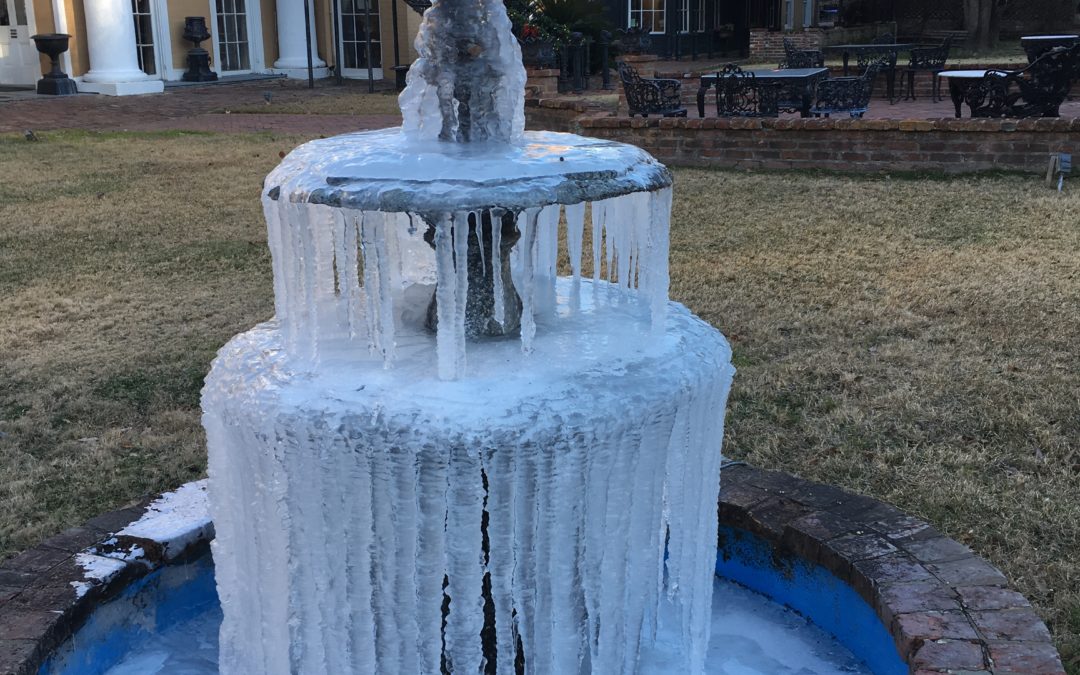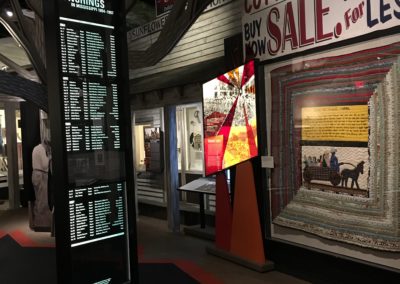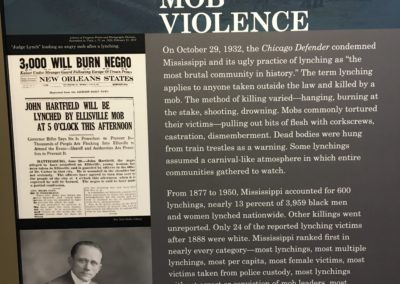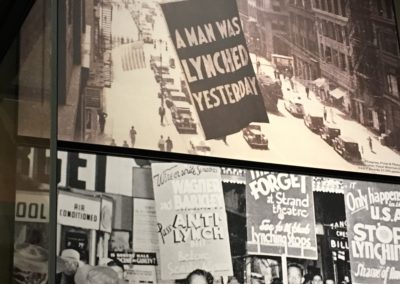Day Five. Monday Jan. 1 Vicksburg
On our New Year’s Day drive from Memphis to Vicksburg, we looked in vain for a lunch spot. Everything was shuttered for the holiday. Finally at 3 p.m. we found a faded sign for “Simply Southern Café and Grill” in Grenada, MS. It was a modest African-American establishment, well worn but well-scrubbed. It offered an “all you care to eat, all-day buffet” for about $10. We had the place to ourselves, except for a young father and his two little kids. We had stumbled on a mecca of southern cooking: perfect fried chicken, collard greens, black eyed peas, peach cobbler and sweet tea.
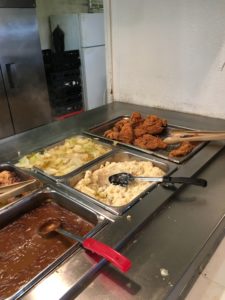
Simply Southern buffet
It was a good thing that it was getting dark when we finally pulled up to the Cedar Grove Mansion Inn, a walled-in antebellum estate with a colorful history. We couldn’t see much of its surrounding neighborhood, a place of dilapidated houses and apartments, broken down vehicles, and random trash. In Cedar Grove’s once-beautiful garden, the cascading fountains had frozen solid. No one had bothered to turn them off. The ceiling fans on the outdoor veranda were also turning, as if we needed further cooling. We shivered on the front steps in 20-degree weather.
Finally a woman answered the door, seeming surprised to see us. We were to be the only guests, except for one other couple who had already disappeared for the night. We ate alone in the once-splendid dining room, eyeing the large cannonball that was still embedded in the wall. The empty tables around us were set with china, linen and crystal, for phantom guests who never came.
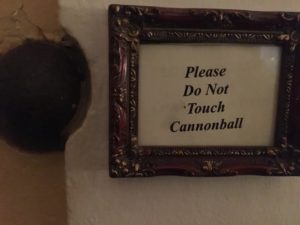
The cannonball in the wall
Cedar Grove’s original mistress was no ordinary Southern belle. She was General Sherman’s Mississippi cousin Elizabeth, who married jeweler John Klein, the richest man in Vicksburg. Klein, who also had banking and railroad interests, presented her with this house as a wedding gift. They had met in Natchez when she was 12, and Klein courted her until she married him four years later. General Sherman rescued her Confederate family as the war came to their doorstep, and when his Union Army overtook Vicksburg, he turned this manor into a Union hospital. The Kleins were allowed to return, and they continued living in suspense upstairs throughout the war, wondering when the Union soldiers would discover their safe of jewels, money and other valuables, in the family dining room. Miraculously, it was never touched. Klein had successfully hidden it in plain sight, disguised as an armoire.
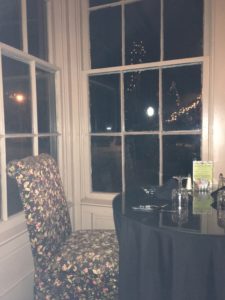
Ready for the guests who never came…
As we retired for the night in a separate building on the estate, I could hear animals—or was it ghosts? rustling around in the woodwork. It was a bleak, cold night, without the cheer of a fire or the charm of other guests.
Day Six. Tuesday Jan.2 Battlefields
The next morning, we ate a rubbery breakfast of scrambled eggs and an impenetrable hotdog the cook tried to pass off as “sausage.” The white toast crumbled to bits when we tried to butter it. The other couple appeared in the dining room, and mumbled a few comments to each other about the toast. The gentleman introduced himself to us as a retired New Orleans police officer, with his lady friend from New York. They agreed that Cedar Grove, which he used to visit regularly, had fallen on hard times.
I asked him about his experiences during Hurricane Katrina. He hadn’t been on duty then, but he said that the storm’s awful impact actually had one beneficial side effect: It cleaned out some of the corruption in New Orleans, by disempowering the levee district boss patronage system established during the old Huey P. Long days. He told us to be sure to visit the Vicksburg battlefield nearby.
We left without knowing where we were going. The wifi hadn’t worked in our room the night before, and our new Honda HRV’s Garmin navigation system had no capacity for historic landmarks or cultural attractions. “Vicksburg Battlefield,” “Civil War battlefield,” “Jackson civil rights museum,” “Mississippi Civil Rights Museum” and “The Hermitage” all produced directions to random gas stations and cafes in different states. I wanted to hit the stupid dashboard with a frozen water bottle. (We had six or seven frozen half bottles rattling around the car, because anything left out overnight was solid by morning.) Our paper maps weren’t local enough to show the streets we needed to find.

Our noble vehicle, whose Navi was embattled
On Confederate Ave., we passed a wooden shack with a hand-lettered sign offering “Live Catfish” and “Fresh Buffalo,” but it appeared to be closed. Finally, thanks to a gas station attendant, we found the Vicksburg Battlefield national park just 10 minutes away. It was forested with stone memorials, scattered on gentle hills. These monuments honored fallen soldiers from Illinois, Iowa, Wisconsin and Ohio. As we left the park, we stepped onto the rotted wooden deck of the ironclad Cairo warship, dredged up from the Yazoo River bottom a few years ago. I wondered what the tour bus full of gray-haired seniors hoped to find here.
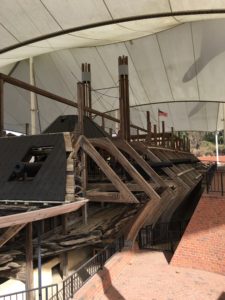
Dredged up from the Mississippi mud
Our next stop: the new Mississippi Civil Rights Museum in Jackson, a perfect counterpoint to the Vicksburg’s lost Confederate glory. This display of the horrors of slavery, reconstruction and the Klu Klux Klan reminded us that the white South’s American dream was everyone else’s nightmare. Before Brown V Board of Education, Mississippi offered only a few months of school each year to segregated black students, with twice as many kids in black classrooms compared to white ones, and only a tiny fraction of the money per student. After they were forced to integrate, many white families put their children into new “segregation academies.”
Most striking were the glass pillars listing every known Mississippi lynching, year by year. Mississippi was the leader in this form of terrorism. Crusading black newspaper editor Ida B. Wells, who was born a slave in Holly Springs, MS, went to England to lecture progressive audiences about how British textile companies were profiting from slavery in the American South. She and others are honored here for challenging the law and culture of the South. There were scary white KKK hoods and photos, along with videos of the Mississippi Freedom Riders, the NAACP and other resisters. We saw no mark recognizing that President Trump, who appears to believe in white supremacy, came to the opening of this new museum less than a month ago. The museum staff seem to be the only people on earth smart enough to ignore this man.
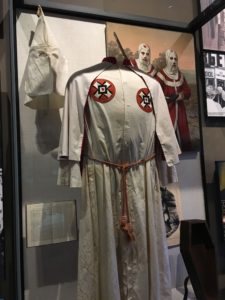
MS Civil Rights Museum
A black woman I passed by in the museum was telling her grandson, “Now look at this history. Learn it.” I wished that instead of tearing down all the Confederate monuments, progressives today would put up new plaques on them, explaining what these men and women thought they were fighting for, and why it was so wrong. A white volunteer stopped me to explain part of the civil rights exhibit, and I told him about the ongoing Not In Our Town (www.niot.org) initiative that helps American communities that have been torn apart by hate crimes. I hope he will spread the word to others. I’ll be volunteering some time with the NIOT team once we get to California on January 15.
“Its amazing that this is all one country,” John said as we drove into a carwash machine outside Patchatoula. A surprising rainbow of colored soap, raining down from above, brightened our outlook. The car had been encrusted with frozen white bird droppings ever since we parked it under a tree in Opryland. We could finally see through the windshield again. as we drove into New Orleans!
NEXT: NEWS ORLEANS AND NATCHEZ
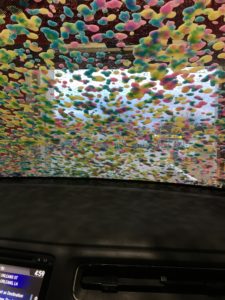
Going through the car wash

